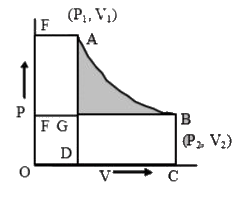An ideal gas is expandend isothermally from(P1V1) and to (P2V2) against a constant external pressure. Which of the following is/are correct regarding above process ?
If Pext=P2 piston will not stop automatically at the final state
If Pext=P2 piston will not stop automatically at the final state
Magnitude of work during expansion can vary in the range of 0≤|W|≤P2(V2−V1)
Work will be zero when Pext is zero and will bre maximum when Pext is eqaul to pressure of system at final state
The correct Answer is:b,c,d
Topper's Solved these Questions
Similar Questions
An ideal gas is expand from (p1,V1,T1) to (p2,V2,T2) under different conditions. The correct statement(s) among the following is (are):
View SolutionGraphically shoe the total work done in an expansion when the state of an ideal gas is changed reversibly and isothermally from (pi,Vi) to (pf,Vf). With the help of a pV plot compare the work done in the above case with that carried out against a constant pressure pf.
View Solution
Knowledge Check
An ideal gas is expand from (p1,V1,T1) to (p2,V2,T2) under different conditions. The correct statement(s) among the following is (are):
AThe work done by the gas is less when it is expanded reversibly from V1 to V2 under adiabatic conditions as compared to that when expanded reversibly from V1 to V2 under isothermal conditionsBThe change in internal energy of the gas is (i) zero, if it is expanded reversibly with T1=T2, and (ii) positive, if it is expanded reversibly under adiabatic conditions with T1≠T2CIf the expansion is carried out freely, it is simultaneously both isothermal as well as adiabaticDThe work done on the gas is maximum when it is compressed irreversibly from (P2,V2) to (P1,V1) against constant pressure P1An ideal gas is expanded from (p1,V1,T1) to (p2,V2,T2) under different conditions. The correct statement (s) among the following is (are)
AThe work done by the gas is less when it is expanded reversibly from V1 to V2 under adiabatic conditions as compared to that when expanded reversibly from V1 to V2 under isothermal conditionsBThe change in internal energy of the gas is (i) zero, if it is expanded reversibly with T1=T2, positive, if it is expanded reversibly under adiabatic conditions with T1≠T2CIf the expansion is carried out freely, it is simultaneously both isothermal as well as adiabaticDThe work done on the gas is maximum when it is compressed irreversibly from (p2,V2) to (p1,V1), against constant pressure p1An ideal gas is expand from (p1,V1,T1) to (p2,V2,T2) under different conditions. The correct statement(s) among the following is (are):
AThe work done by the gas is less when it is expanded reversibly from V1 to V2 under adiabatic conditions as compared to that when expanded reversibly from V1 to V2 under isothermal conditions.BThe change in internak energy of the gas is (i) zero, if it is expanded reversibly with T1=T2 and (ii) Positive, if it is expanded reversibly under adibatic conditions with T1≠T2.CIf the expansion is carried out freely, it is simultaneously both isothermal as well as adiabatic.DThe work done on the gas is maximum when it is compressed irreversibly from (p2V2) to (p1V1) against constant pressure p1.
Graphically shoe the total work done in an expansion when the state of an ideal gas is changed reversibly and isothermally from (pi,Vi) to (pf,Vf). With the help of a pV plot compare the work done in the above case with that carried out against a constant pressure pf.
View SolutionAn ideal gas is expand from (p1,V1,T1) to (p2,V2,T2) under different conditions. The correct statement(s) among the following is (are):
View SolutionAn ideal gas is expand from (p1,V1,T1) to (p2,V2,T2) under different conditions. The correct statement(s) among the following is (are):
View SolutionAn ideal gas is transformed from state A(P1,V1) to the state B(P2,V2) through path AB. In this process the work done by the gas is

View SolutionAn ideal gas follows a process described by PV2=C from (P1,V1,T1) to (P2,V2,T2) (C is a constant). Then
View Solution
